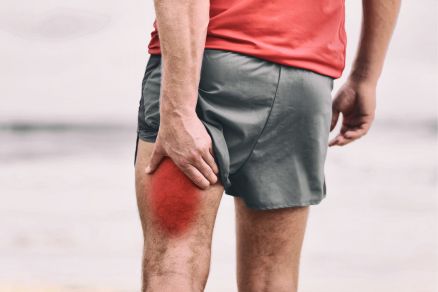Sciatica refers to pain caused by irritation or compression of the sciatic nerve, which is the longest and widest nerve in the human body. The sciatic nerve originates in the lower back and runs through the buttocks and down the lower limbs. It provides sensation and motor function to the legs. Sciatica can occur when a spinal disc herniates and presses on the nerve roots as they exit the spinal cord or if there is irritation elsewhere along the nerve pathway. The hallmark symptom is radiating leg pain, often accompanied by numbness, tingling, and muscle weakness. Understanding the anatomy, causes, diagnosis, and treatment options helps patients better manage this common nerve pain syndrome.
Anatomy and Function of the Sciatic Nerve
The sciatic nerve is formed by the lumbar and sacral nerve roots exiting the lower spinal cord. It originates from the L4 to S3 nerve roots, though L4, L5, and S1 are most commonly involved in sciatica. After exiting the spinal column through the intervertebral foramen, the nerve roots converge and intermingle to form a single large sciatic nerve. This exits the pelvis through the greater sciatic foramen below the piriformis muscle.
The sciatic nerve then descends deep in the butt muscles at the back of the thigh before branching above the knee near the mid-femur. It splits into the tibial nerve and the common fibular nerve. These provide motor and sensory innervation to the lower leg and foot. Overall, the sciatic nerve supplies sensation and strength to the thigh, calf, foot, and entire lower limb. Damage or compression of the nerve roots or sciatic nerve anywhere along its course can lead to sciatica.
Causes of Sciatica
Common causes of sciatic nerve pain include:
- Lumbar herniated disc – Pressure on nerve roots from disc protrusion is the most frequent cause. Usually occurs at the L4-L5 or L5-S1 level.
- Degenerative disc disease – Age-related wear and tear allows discs to bulge or herniate more easily.
- Spinal stenosis – Narrowing of the spinal canal compresses nerve roots. Congenital or acquired from aging spine changes.
- Spondylolisthesis – Vertebral slippage due to joint instability compresses nerve roots.
- Piriformis syndrome – Sciatic nerve compressed where it passes under the piriformis muscle in the buttock.
- Trauma or injury – Fractures of the lumbar spine or pelvis can damage the sciatic nerve.
- Pregnancy – Weight gain, posture changes, and fluid retention during pregnancy can irritate the sciatic nerve.
- Bone spurs – Osteophytes intruding into the spinal canal may pinch nerve roots.
- Infection – Abscess or swelling due to infection near the spine or pelvis impacts the nerve.
- Tumors – Benign or malignant masses in the lumbar spine compress nerves.
- Avascular necrosis – Loss of blood supply to the top of the femur can cause sciatica.
In most cases, sciatica results from compression or irritation of the nerve roots as they exit the lower spine. Herniated discs, bone spurs, constricted space from stenosis, and spondylolisthesis all affect the nerve at its most narrow point in the vertebral foramen. Less often, sciatic nerve pain originates along other areas of the nerve pathway through the buttock or thigh.
Sciatica Symptoms
Classic symptoms of sciatica include:
- Radiating leg pain – Starts in the lower back or buttock and radiates down the back or side of the leg, following the sciatic nerve pathway. Usually only on one side.
- Numbness, tingling, burning – In the back of the thigh, calf, foot, or toes depending on where the nerve is impacted.
- Muscle weakness – Most notable with ankle dorsiflexion or great toe extension. The foot may drag or slap when walking.
- Reflex changes – Reduced or absent Achilles reflex due to nerve root impingement.
- Low back pain – Variable, but often worse with prolonged sitting and bending forward. Improves with walking.
- Shooting leg pain with coughing or sneezing
Symptoms are typically aggravated by activities that increase spinal pressure or tension on nerve roots like bending, twisting, prolonged sitting, and impact exercises. Coughing can also exacerbate symptoms. Pain may interfere with normal leg function causing limping or difficulty with knee flexion when walking. Sciatica pain is rarely present bilaterally – it usually occurs along the pathway of just one sciatic nerve.
Diagnosing Sciatica
Doctors diagnose sciatica based on a detailed history of the nature and timing of symptoms, along with a physical exam. Important aspects of assessment include:
- Location of pain – Follows sciatic nerve pathway
- Pain triggers and relievers – What makes it worse or better? Sitting, bending, walking
- Numbness distribution – Dermatomal pattern
- Muscle strength testing – Any focal foot or ankle weakness
- Reflex evaluation – Reduced Achilles reflex suggests nerve root impingement.
- Straight leg raise test – Reproduces radiating leg pain
Red flags like bowel/bladder changes, fever, trauma, or history of cancer warrant urgent investigation to rule out serious underlying pathology requiring immediate treatment.
If the clinical picture is consistent with sciatica, imaging studies may be obtained to confirm and locate the source of nerve root compression. Useful diagnostic imaging includes:
- Lumbar X-rays – Assess spine alignment and screen for fractures or malignancies.
- MRI – Provides detailed images of spinal discs, nerves, and soft tissues. Best for pinpointing disc herniations or lesions impinging on nerve roots.
- CT scan – Useful for visualizing bony spurs or stenosis contributing to nerve compression.
- EMG/nerve conduction studies – Measures electrical activity in muscles and nerves. Can confirm sciatic nerve dysfunction.
Most cases of sciatica can be diagnosed clinically based on symptoms of radiating leg pain and exam findings of nerve root tension signs, reflex changes, and sensory disturbances in a dermatomal distribution. Imaging may be considered for surgical planning or if the diagnosis is uncertain.
Treating Sciatica
Initial treatment for acute sciatica focuses on symptom relief. Primary interventions include:
- Activity modification – Avoid positions and activities that aggravate symptoms. Temporary bed rest can calm acute inflammation.
- Ice packs – Applying ice for 15-20 minutes helps decrease inflammation around irritated nerve roots.
- Medications – Over-the-counter NSAIDs like ibuprofen and naproxen help relieve pain and inflammation. Other medications including gabapentin, muscle relaxers, and prescription NSAIDs may be used as well.
- Brace – Wearing a lumbar brace provides external spinal support and limits motion. Used temporarily during acute spasms.
- Physical therapy – Stretches and exercises help maintain strength and mobility. Spinal traction may provide temporary decompression.
- Epidural steroid injections – Steroids injected into the epidural space surrounding inflamed nerve roots can calm local inflammation.
- Lifestyle factors – Smoking cessation, weight loss, and controlling chronic disease may decrease symptoms.
Surgery may be considered if pain persists after at least 6 weeks of nonsurgical treatment. Surgical options include:
- Microdiscectomy – Removing the portion of a herniated disc impinging on a nerve root. Most common procedure.
- Laminectomy – Taking out the posterior portion of a vertebra to increase space for nerves.
- Laminotomy – Selectively removing a small portion of lamina and bone spur compressing nerves.
- Discectomy and spinal fusion – Removing the entire disc and fusing two vertebrae together for stability.
The vast majority of patients improve with conservative treatment, but surgery provides definitive nerve root decompression for those with persistent and disabling leg pain.
Preventing Sciatica
Strategies to help prevent sciatic nerve pain include:
- Maintaining proper posture and core strength to support the lower back.
- Use ergonomic chairs and workstations to avoid prolonged awkward positions.
- Avoid repetitive bending, twisting, and heavy lifting, especially when spine muscles are fatigued.
- Losing excess weight reduces stress on the lower back and discs.
- Doing regular lower back stretches and exercises to keep muscles flexible and strong.
- Using good body mechanics and proper lifting form.
- Quitting smoking, which impairs disc health.
- Treating underlying chronic conditions like diabetes.
- Choosing low-impact exercises to reduce wear and tear on the spine.
While sciatica can arise suddenly, taking precautions helps avoid putting excessive strain and pressure on the lower back and sciatic nerve. Mindfulness about posture, ergonomics, core strength, and spinal health can potentially avoid many cases of sciatic nerve irritation.
Sciatica is a common cause of radiating leg pain and numbness that results from compression or irritation of the sciatic nerve. Typical triggers include lumbar disc herniation, spinal stenosis, and spondylolisthesis putting pressure on the nerve roots as they exit the spine. Diagnosis is based on symptoms of pain following the sciatic nerve dermatome and supportive physical exam findings. Though often extremely painful, sciatica usually resolves within weeks with conservative treatment like rest, medications, ice, and physical therapy. Surgery may provide more rapid relief but is only required in a small percentage of patients with persistent disabling leg pain. With a combination of patient education, activity modification, and access to both medical and physical therapy interventions, the prognosis for most sciatica patients is excellent

Chris Hanks is an experienced physical therapist based in Austin, Texas. He earned his Doctor of Physical Therapy degree from the University of Texas at Austin in 2005 after completing his Bachelor of Science in Kinesiology in 2002. Dr. Hanks has been a licensed PT in Texas since 2005. He began his career at Central Texas Rehabilitation Hospital before moving to Austin Sports Medicine Center in 2010. In 2015, Dr. Hanks opened his own clinic, Capital City Physical Therapy, where he continues to treat patients.






